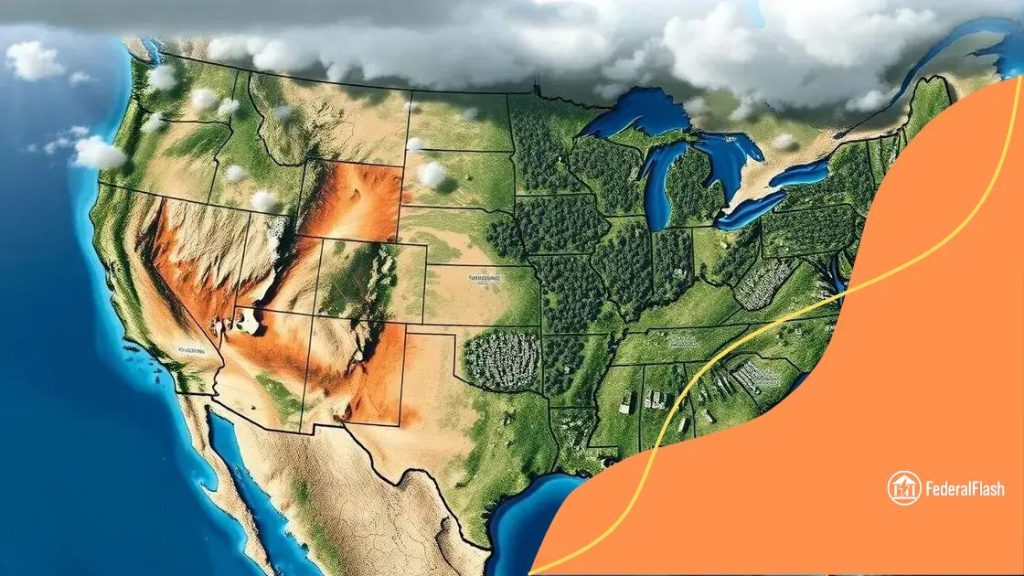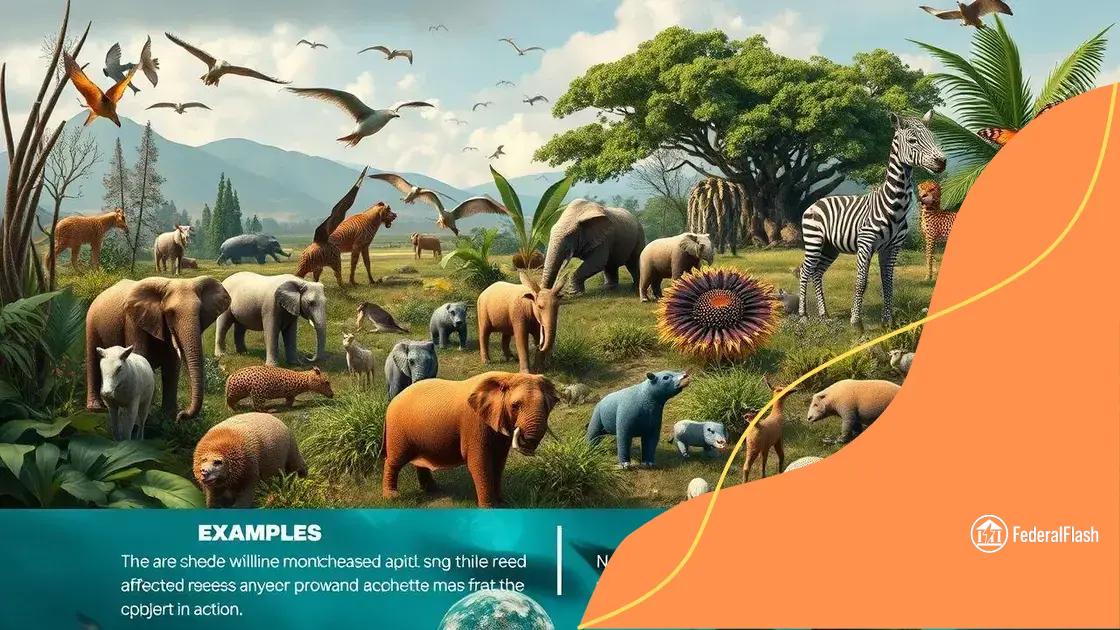The impact of climate change on specific regions of the US

Anúncios
The impact of climate change on specific regions of the US includes effects on agriculture, wildlife, and community resilience, necessitating proactive policies and sustainable practices to adapt effectively.
The impact of climate change on specific regions of the US is more than just rising temperatures; it affects our daily lives, economies, and natural ecosystems. Have you noticed changing weather patterns in your area? Let’s dive into how these changes are unfolding across the country.
Anúncios
Understanding regional climate variations
Understanding regional climate variations is essential to grasp the full impact of climate change. Different areas of the US experience climate shifts uniquely. For example, while one region may face increasing droughts, another could see heavier rainfall.
Factors Influencing Regional Climate
Several factors contribute to these variations. Geography plays a huge role, from mountains to oceans. Local ecosystems reflect these changes, impacting agriculture and wildlife.
Key Influences Include:
- Proximity to water bodies
- Elevation and terrain
- Urbanization effects
- Weather patterns and jet streams
Additionally, climate models indicate that specific regions will likely continue on distinct paths. For instance, coastal regions may endure rising sea levels, altering landscapes and habitats. Inland zones might struggle with increased temperature variation, experiencing more extreme weather.
Anúncios
In some places, wildlife is adapting to these changes. Species migration is becoming more common as animals search for suitable environments. This process is crucial for their survival amid shifting climates.
Adaptations in Local Ecosystems
Communities also respond to these climate variations. Farmers may alter crop selection based on emerging climate patterns. Cities might invest in better infrastructure, addressing flooding risks and heat islands.
It’s fascinating to see how interconnected everything is. As we understand these regional variations better, we can implement effective strategies for resilience. Awareness and education are vital tools in addressing the challenges presented by our changing climate.
Effects on agriculture and food supply
The effects on agriculture and food supply due to climate change are significant and wide-reaching. As the climate continues to shift, farmers face challenges that impact their crops and livestock. Some regions may see increased yields, while others experience declines. Understanding these variations is crucial.
Impact of Weather Patterns
Weather patterns are changing, leading to unpredictable growing seasons. Droughts can devastate entire harvests, while excessive rainfall may cause flooding, ruining crops. Farmers must adapt to these conditions to sustain their livelihoods.
Key Effects Include:
- Changing planting dates
- Increased pests and diseases
- Reduced quality of crops
- Challenges in livestock management
The food supply chain also faces pressure. As regions adapt to new agricultural practices, food prices may rise. This affects not only farmers but also consumers who rely on these products. Higher prices can lead to food insecurity, especially in vulnerable communities.
In response to these changes, many farmers are adopting innovative strategies. Techniques such as crop rotation and sustainable practices help improve resilience against climate impacts. Educating farmers about new technologies plays a crucial role in enhancing food security.
Importance of Sustainable Practices
Investing in sustainable agriculture is vital. Practices that focus on conservation and resource optimization can mitigate some adverse effects. Emphasizing permaculture and regenerative methods enhances soil health and increases biodiversity, creating a more resilient agricultural system.
As climate change continues to unfold, it is essential to monitor and adapt to these effects. Continued research and investment in supportive policies will aid farmers in overcoming challenges. Together, these efforts contribute to a more stable food supply for future generations.
Impact on local wildlife biodiversity

The impact on local wildlife biodiversity due to climate change is profound. As temperatures rise and habitats shift, many species are forced to adapt or face extinction. This disruption creates ripple effects throughout ecosystems.
Shifts in Habitats
Many animals are moving to cooler areas as their original habitats become uninhabitable. This migration can lead to competition for resources in new environments. Some species thrive under these changes, while others struggle to survive.
Key Changes Include:
- Loss of natural habitats
- Changes in migration patterns
- Increased vulnerability of certain species
- Altered food chains
Additionally, the introduction of invasive species can further threaten local wildlife. As climate conditions change, non-native species may spread into new territories, outcompeting native populations for food and habitat.
Amphibians, for example, are particularly sensitive to these changes. Many species face habitat loss due to climate extremes, leading to sharply declining populations. Protecting these fragile ecosystems is essential for maintaining biodiversity.
Conservation Efforts
Effective conservation strategies focus on preserving habitats and supporting wildlife adaptation. Creating wildlife corridors can help animals migrate safely. Restoring native plants also supports local species and improves ecosystem resilience.
Education and community involvement are crucial for successful conservation. By raising awareness of the importance of biodiversity, communities can take action and support local wildlife. The survival of many species hinges on our understanding and response to the impacts of climate change.
How communities are adapting to changes
How communities are adapting to changes caused by climate change is increasingly important. As climate impacts become evident, many communities are finding innovative ways to respond. These actions help them become more resilient against environmental shifts.
Community Initiatives
Local governments and organizations are implementing initiatives focusing on sustainability. These efforts often include enhancing green spaces and decreasing carbon footprints. By prioritizing public transportation and energy efficiency, communities can make significant strides in minimizing their impact.
Examples of Adaptation Strategies:
- Building flood defenses to protect against rising sea levels.
- Promoting community gardens to increase local food production.
- Investing in renewable energy sources like solar and wind.
- Implementing water conservation practices to manage scarcity.
Additionally, education plays a crucial role. Schools and community centers often host workshops to inform residents about sustainable practices. Knowledge exchange allows families to understand and embark on eco-friendly practices in their daily lives.
Resilient communities also involve engaging local stakeholders in decision-making. Collaboration between residents, businesses, and government entities fosters a unified approach to addressing climate changes. By working together, they can share resources and overcome challenges more effectively.
Encouraging Community Participation
Participation boosts morale and encourages collective responsibility for environmental issues. Volunteer activities, like clean-up drives or tree planting events, help build a sense of community. When people come together to take action, they strengthen their bonds and their commitment to sustainability.
As the impacts of climate change become more apparent, communities that adapt quickly will likely fare better. Building resilience requires openness to change and collaboration, empowering local residents to take charge of their futures. Every small effort adds up and contributes to a larger movement toward sustainability.
Policy responses and future outlook
The policy responses to climate change are crucial in shaping our future outlook. Governments worldwide are beginning to recognize the urgent need to address climate change through effective legislation and community engagement. Coordinated efforts can lead to sustainable solutions benefiting both people and the planet.
Current Policy Measures
Many countries are implementing policies focused on reducing carbon emissions. These measures often include transitioning to renewable energy sources and improving energy efficiency. By promoting sustainable practices, governments aim to mitigate the impacts of climate change.
Key Policy Actions Include:
- Setting greenhouse gas reduction targets.
- Incentivizing clean energy adoption.
- Investing in public transportation to reduce air pollution.
- Encouraging sustainable agricultural practices.
International agreements, such as the Paris Agreement, also play a significant role. These agreements aim to unite countries in the fight against climate change by committing to specific targets. Cooperation among nations is vital for achieving meaningful progress.
Local governments are also taking action. They can introduce regulations that encourage sustainability in communities. For example, creating green building standards and promoting local food systems helps cities adapt to climate change impacts.
Future Outlook
The future outlook depends on how quickly and effectively policies are implemented. Increased awareness and climate education can influence public support for necessary changes. This support enables lawmakers to push for ambitious climate goals.
Investing in resilience measures is equally essential. Protecting natural habitats and restoring ecosystems will help communities adapt to changing conditions. While challenges exist, a proactive approach can lead to innovative solutions and sustainable development.
Overall, the success of climate policies will require continuous evaluation and improvement. Engaging the public, fostering collaboration, and embracing new technologies are crucial components in creating a resilient future.
In conclusion, the impact of climate change on various aspects of our lives is undeniable. From agriculture to wildlife, understanding these changes is crucial. It is imperative for communities to adapt through effective policies, sustainable practices, and active engagement. Together, these efforts pave the way for a resilient future, allowing us to combat climate change and protect our planet for generations to come.
FAQ – Questions about the impact of climate change on the US
How does climate change affect local wildlife?
Climate change disrupts habitats, forcing some species to migrate, which can lead to increased competition and challenges for native populations.
What policies are being implemented to combat climate change?
Governments are setting greenhouse gas reduction targets, promoting renewable energy, and encouraging sustainable practices to mitigate climate impacts.
How can communities adapt to climate changes?
Communities are adopting sustainable practices through local initiatives, engaging in conservation efforts, and participating in climate education programs.
What effects does climate change have on agriculture?
Climate change can lead to unpredictable weather patterns, affecting crop yields and food supply, which requires farmers to adapt their practices.